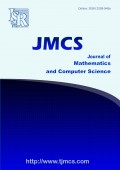Decision-making for a Single Item EOQ Model with Demand-dependent Unit Cost and Dynamic Setup Cost
-
4071
Downloads
-
5613
Views
Authors
M. Pattnaik
- Department of Business Administration, Utkal University, Bhubaneswar, India
Abstract
A Single item EOQ model is modeled using crisp arithmetic approach in decision making
process with demand unit cost and dynamic setup cost varies with the quantity
produced/Purchased. This paper considers the modification of objective function and storage
area in the presence of estimated parameters. The model is developed for the problem by
employing NLP modeling approaches over an infinite planning horizon. It incorporates all
concepts of crisp arithmetic approach, the quantity ordered, the demand per unit and compares
with other model that of the crisp would optimal ordering policy of the problem over an infinite
time horizon is also suggested. Investigation of the properties of an optimal solution allows
developing an algorithm for obtaining solution through LINGO 13.0 version whose validity is
illustrated through an example problem. Sensitivity analysis of the optimal solution is also
studied with respect to changes in different parameter values and to draw managerial insights.
Share and Cite
ISRP Style
M. Pattnaik, Decision-making for a Single Item EOQ Model with Demand-dependent Unit Cost and Dynamic Setup Cost , Journal of Mathematics and Computer Science, 3 (2011), no. 4, 390--395
AMA Style
Pattnaik M., Decision-making for a Single Item EOQ Model with Demand-dependent Unit Cost and Dynamic Setup Cost . J Math Comput SCI-JM. (2011); 3(4):390--395
Chicago/Turabian Style
Pattnaik, M.. "Decision-making for a Single Item EOQ Model with Demand-dependent Unit Cost and Dynamic Setup Cost ." Journal of Mathematics and Computer Science, 3, no. 4 (2011): 390--395
Keywords
- Single item
- EOQ
- Unit cost
- Dynamic setup cost
MSC
References
-
[1]
T. C. E. Cheng, An economic order quantity model with demand-dependent unit cost, Eur. J. Oper. Res., 40 (1989), 252--256
-
[2]
G. U. Tinarelli, Inventory control models and problems, Eur. J. Oper. Res., 14 (1983), 1--12
-
[3]
T. M. Whitin, Inventory control research and survey, Manag. Sci., 1 (1954), 32--40
-
[4]
T. K. Roy, M. Maiti, A fuzzy EOQ model with demand dependent unit cost under limited storage capacity, Eur. J. Oper. Res., 99 (1997), 425--432
-
[5]
T. K. Roy, M. Maity, A fuzzy inventory model with constraint, Operational Research Society of India, 32 (1995), 287--298
-
[6]
P. K. Tripathy, M. Pattnaik, Optimal inventory policy with reliability consideration and instantaneous receipt under imperfect production process, International Journal of Management Science and Engineering Management, 6 (2011), 413--420
-
[7]
P. K. Tripathy, M. Pattnaik, Optimization in an inventory model with reliability consideration, Appl. Math. Sci., 3 (2009), 11--25
-
[8]
M. Pattnaik, Entropic order quantity (EnOQ) model under Cash Discounts, Thailand Statistician journal, 9 (2011), 129 --141
-
[9]
P. K. Tripathy, M. Pattnaik, An fuzzy arithmetic approach for perishable items in discounted entropic order quantity model, International Journal of Scientific and Statistical Computing, 1 (2011), 7--19
-
[10]
A. J. Clark, An informal survey of multi echelon inventory theory, Naval Research Logistics Quarterly, 19 (1972), 621--650
-
[11]
G. Hadley, T. M. Whitin, Analysis of inventory systems, Prentice-Hall, Englewood Clipps (1963)
-
[12]
H. A. Taha, Operations Research: an introduction, Macmilliion, New York (1976)

